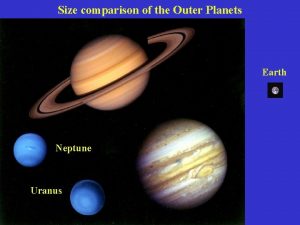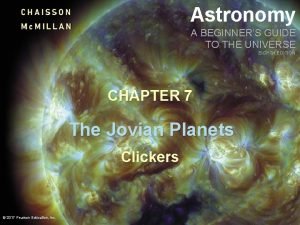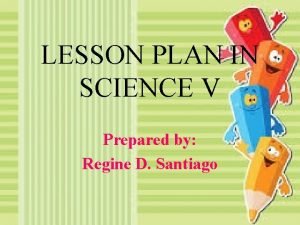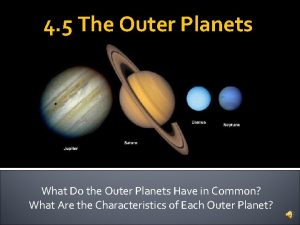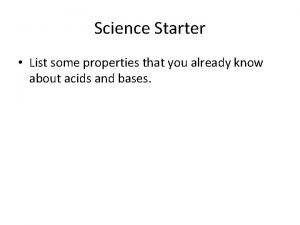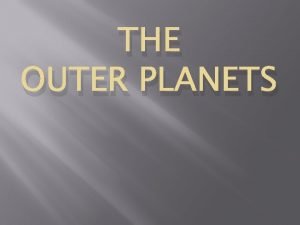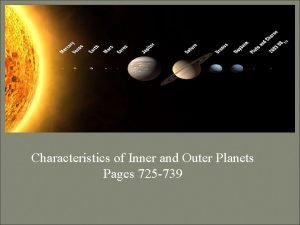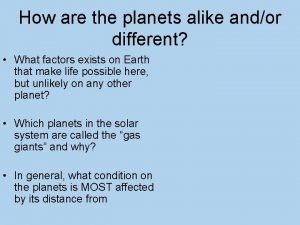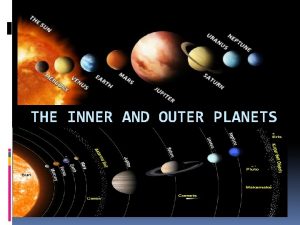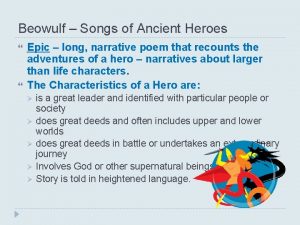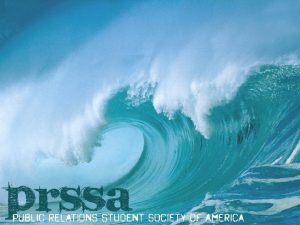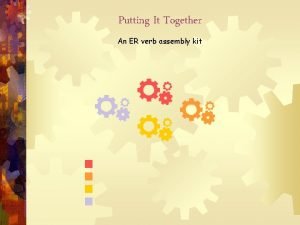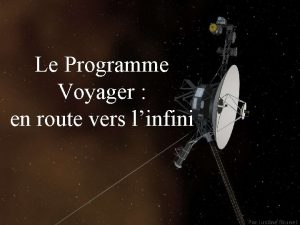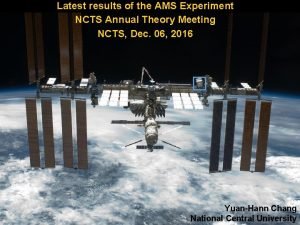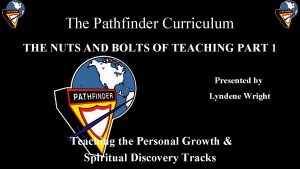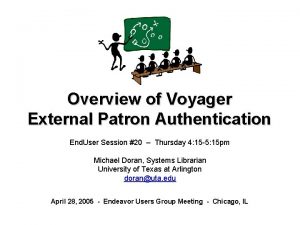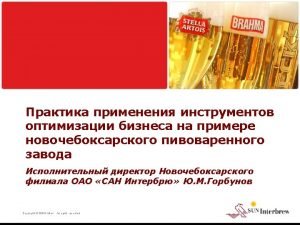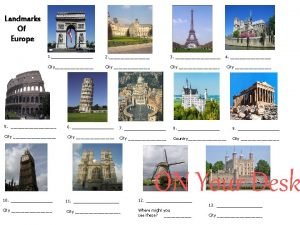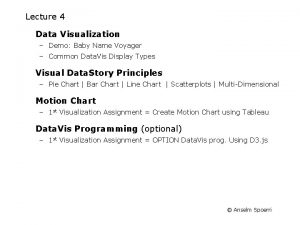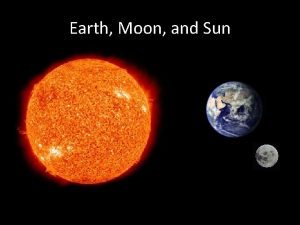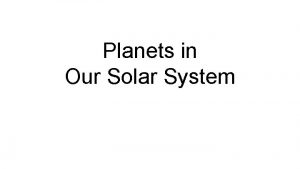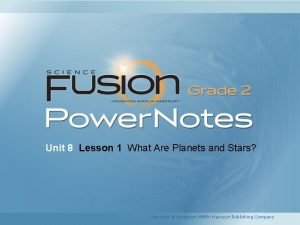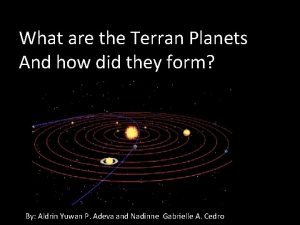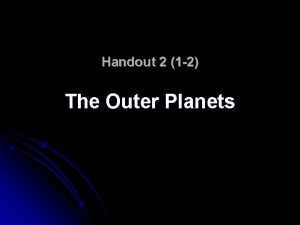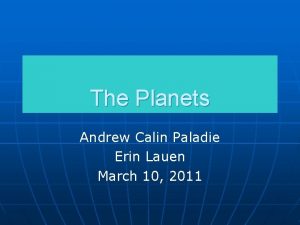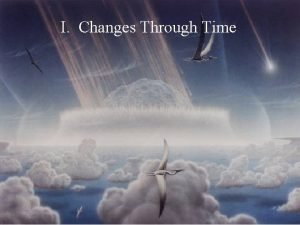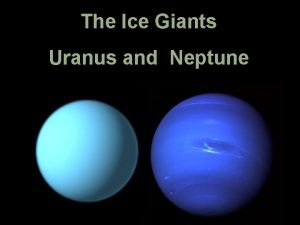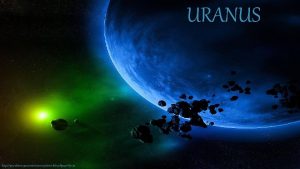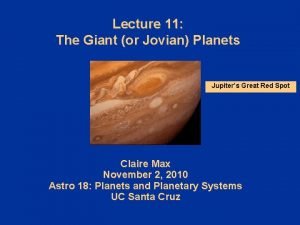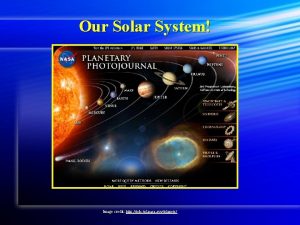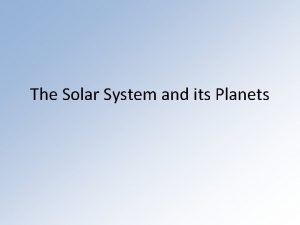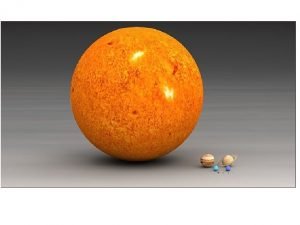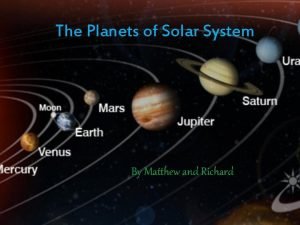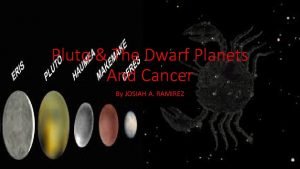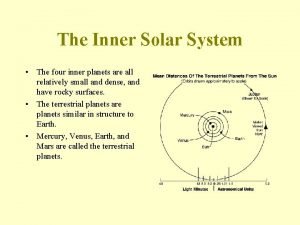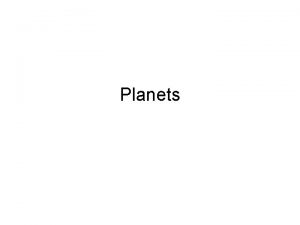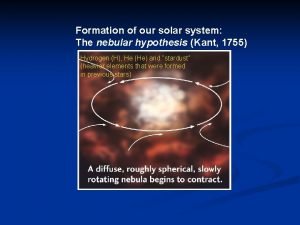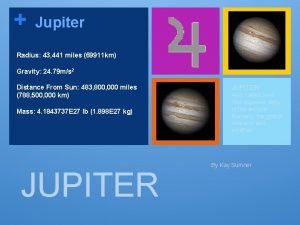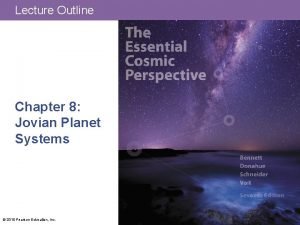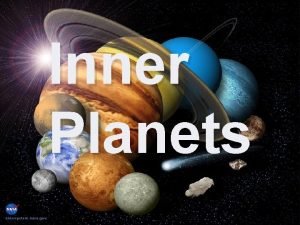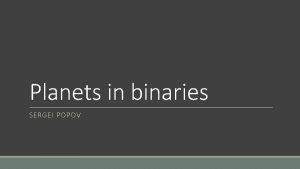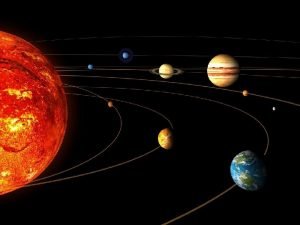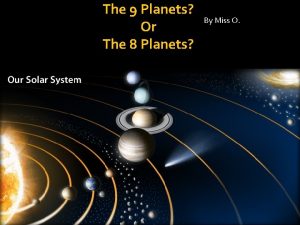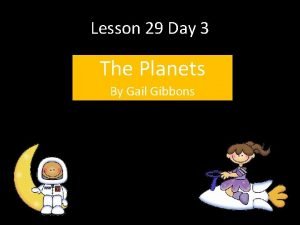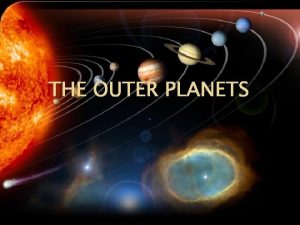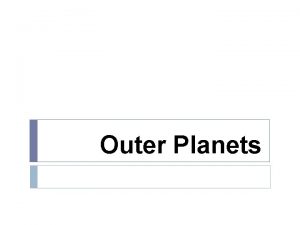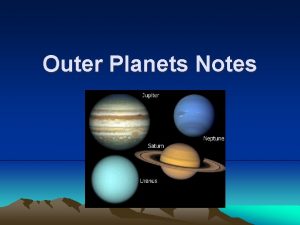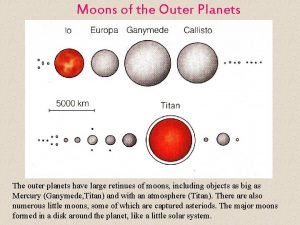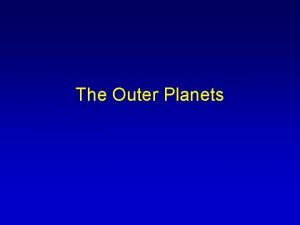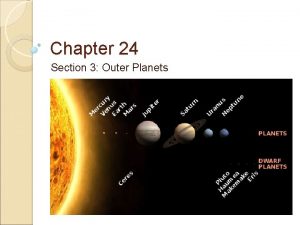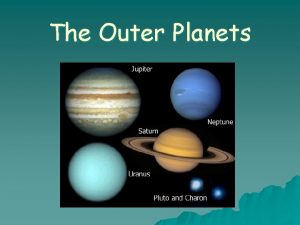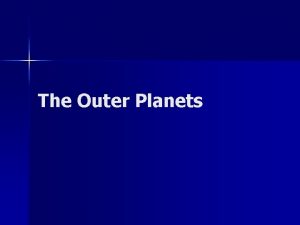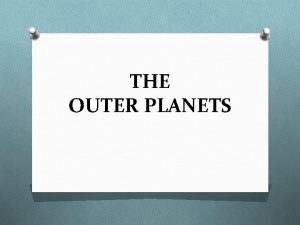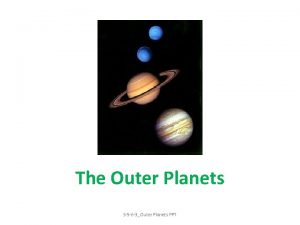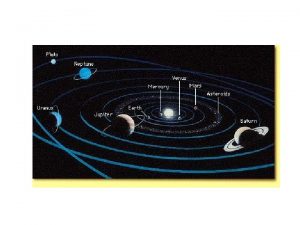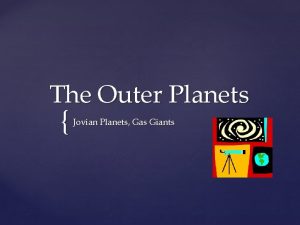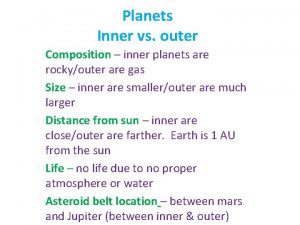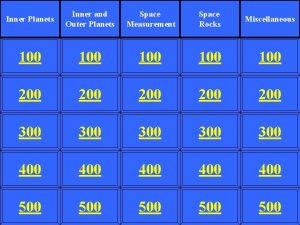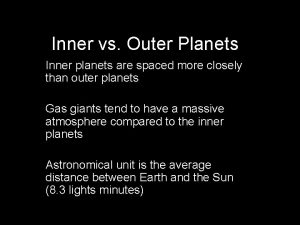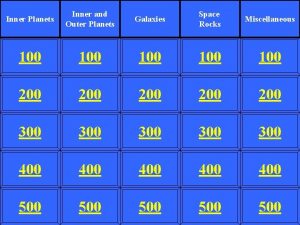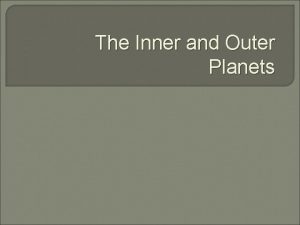OUTER PLANETS VOYAGER 1 2 Voyager 1 is
































































- Slides: 64

OUTER PLANETS

VOYAGER 1 & 2 • Voyager 1 is a 722 -kilogram (1, 592 lb) space probe launched by NASA on September 5, 1977, to study the outer Solar System. • Now traveling at a velocity of 38, 000 mph • On September 12, 2013, NASA announced that Voyager 1 had crossed the heliopause and entered interstellar space


Jupiter


Click for animations

Jupiter • 5 th planet, day= 10 hrs year= 11. 8 yrs • Greatest volume (1 ½ times greater than others) • Greatest mass (2 x greater than all others combined) • Made of helium and hydrogen [why not a star? Not big enough. . . sun is 1000 x bigger than Jupiter] • Red spot-giant hurricane • Named after Roman king of gods • Prograde rotation

Jupiter’s biggest moons

Moon europa

Surface may be 100 miles thick with ice with a watery ocean below

More water on Europa than here

The internal water is warmed by the core


Surface continually cracks and refreezes

Artist’s imagination of Europa

Moon Io

See the volcano going off to the left at the equator?

Most volcanically active object in solar system

Ganymede

View of Jupiter from Ganymede— artist imagination

Ganymede is bigger than our moon

Callisto- may have underground oceans

Moons are tiny compared to Jupiter

Jupiter’s moons • 67 moons • Io-most volcanically active object in the solar system • Callisto- has underground water • Ganymede- largest moon in the solar system and has frozen water • Europa- icy crust & underground oceans (maybe life? )

Saturn

SEE THE AURORA ON THE SOUTH POLE OF SATURN?

Rings are not solid… made of rocks, sand dust



Saturn’s “shepherd” moons

Saturn’s biggest moon Titan

Nitrogen atmosphere and organic molecules

Saturn • • • 6 th planet day 10 hr 40 min year=29 earth years least dense (would float in water) Rings of dust and rock Made of helium and hydrogen Giant lightning storms the size of the US 37 moons Titan – largest moon – (has atmosphere with nitrogen on it and maybe life? ) – Visited by Huygens probe (European)

Uranus

Spins sideways

Uranus • • Day= 17 hrs Year= 83 years Retrograde rotation “sideways” planet due to 98* tilt of axis named after Roman god of Titans 27 moons (none of interest) Methane gas give it blue-green color (methane absorbs red and yellow light)

Neptune

Great dark spot- massive tornado

Neptune compared to earth

Wind speeds faster than the speed of sound!

Triton--Neptune’s biggest moon

Neptune • • 8 th planet day=16 hr year=163 yrs named after Roman god of sea Frozen methane gas gives it a whitish blue green color System of faint rings Great dark spot—massive tornado Winds blow 1200 mph (almost 2 x the speed of sound!) It may rain diamonds in atmosphere 13 moons – Triton-largest moon – Nitrogen geisers and water/ammonia eruptions – Coldest body in the solar system

KUIPER BELT OBJECTS

Kuiper Belt Objects • Elliptical plane past Neptune filled with icy objects

Kuiper Belt Objects PLUTO • planetesimal / dwarf planet • day= 6 days • year= 248 yrs • named after Roman god of underworld • composed of rock, ice, and frozen gases • Has 5 moons • charon- moon that is ½ size of its planet • very little atmosphere


Pluto

Super duper x-ray vision revealed. .

Size of pluto and its moon charon

SEDNA

picture of Eris


Haumea – no real pics yet

Makemake (mah kay) • We have no real pictures yet

Kuiper Belt Objects • • SEDNA – 10, 500 year orbit ERIS – 580 year orbit, bigger than pluto HAUMEA – egg shaped MAKE – 2/3 size of pluto


• SPHERICAL SHAPED ZONE • THE DONUT SHAPED THING IS THE KUIPER BELT • CONTAINS ICY OBJECTS EVEN FURTHER OUT • THIS IS AS FAR AS THE SUN’S GRAVITY CAN REACH OORT CLOUD

OORT CLOUD • Spherical cloud of icy objects further out than the Kuiper belt OORT CLOUD

COMETS • Comets – large chunk of ice, dust, frozen gas, and rock moving through space (dirty snowball) • Usually dislodged by the gravity of a planet passing by • Nucleus—center of a comet • Coma—cloud of vaporized (turned to gas) ice that surrounds the nucleus • Tail—the coma of a comet that is being blown back by solar winds • Halley’s Comet—short period comet (has an orbit of less than 200 years) that returns every 76 years (2061)

Meteroids--small rocks in space • made of broken asteroids or • broken comets

Meteors—a small rock that has entered a planet’s atmosphere (making a streak of light) • friction with the atmosphere wears off tiny pieces of the meteor causing it to heat up, glow, and eventually disintegrate • most are sand-sized

Meteorites —a small rock that strikes a planet’s surface • the meteor is big enough to not completely disintegrate before making contact • baseball/softball sized • *These are all the same rock but are renamed based on WHERE they are located

How the solar system formed: • Nebula- (cloud of dust and gas) begins to rotate • Gravity in the center pulls dust and gas inward • Friction in center causes temperature in center to reach 10 million degrees C • Fusion begins and a star is born • Solar winds blow gases far away, but have little effect on nearby rocks and dust • Accretion (collisions of matter that cause planets to grow) occurs – Rock collisions = terrestrial planets – Gas collisions = gaseous planets

How distances are measured: Short space distance: • Astronomical unit=distance between sun and earth Long space distance: • Light year- distance light travels in 1 year • Light travels 186, 000 miles per second • 6 trillion miles per year • Alpha centauri is 4 light years away, so it is 24 trillion miles away
 Outer planets atmosphere
Outer planets atmosphere What separates the inner planets and outer planets
What separates the inner planets and outer planets What separates the inner planets and outer planets
What separates the inner planets and outer planets Inner planets and outer planets
Inner planets and outer planets How are terrestrial planets different from jovian planets?
How are terrestrial planets different from jovian planets? Characteristics of outer planets
Characteristics of outer planets Pioneer 11 pictures of saturn
Pioneer 11 pictures of saturn Jupiter and saturn are noticeably oblate because:
Jupiter and saturn are noticeably oblate because: Is venus terrestrial or gaseous
Is venus terrestrial or gaseous The two outer jovian planets appear bluish in color because
The two outer jovian planets appear bluish in color because Inner outer planets venn diagram
Inner outer planets venn diagram What do all the outer planets have in common
What do all the outer planets have in common Outer planets
Outer planets Inside pluto planet
Inside pluto planet Uranus distance from sun
Uranus distance from sun Planet andor
Planet andor Characteristics of outer planets
Characteristics of outer planets Characteristics of outer planets
Characteristics of outer planets What separates the inner and outer planets
What separates the inner and outer planets Star trek voyager beowulf
Star trek voyager beowulf Uh manoa voyager
Uh manoa voyager High risk voyager zones a b c d
High risk voyager zones a b c d Conjugate voyager
Conjugate voyager Sonde voyager : en route vers l'infini
Sonde voyager : en route vers l'infini The voyager
The voyager Pathfinder bible verse
Pathfinder bible verse Authentication adaptors
Authentication adaptors Voyager ils
Voyager ils Voyager pad
Voyager pad Vmath intervention
Vmath intervention Nedbank credit card travel insurance 2019
Nedbank credit card travel insurance 2019 Voyager plant optimization
Voyager plant optimization Voyager pad
Voyager pad Yti voyager
Yti voyager Namevoyager
Namevoyager Sun earth
Sun earth Inner planets
Inner planets Planets. lesson 1
Planets. lesson 1 Terran planets
Terran planets Inner planets matching
Inner planets matching How many spacecrafts have visited mercury
How many spacecrafts have visited mercury Planets lesson 1
Planets lesson 1 Relative size planets
Relative size planets Coldest planets
Coldest planets Http://solarsystem.nasa.gov/planets/
Http://solarsystem.nasa.gov/planets/ Why do jovian planets have rings
Why do jovian planets have rings Http://pds.jpl.nasa.gov/planets/
Http://pds.jpl.nasa.gov/planets/ Goldilocks planets
Goldilocks planets Rocky planet surface
Rocky planet surface Today planetary position
Today planetary position Planets in order
Planets in order Is josiah a dwarf
Is josiah a dwarf Holst the planets lesson plan
Holst the planets lesson plan The four inner planets of our solar system are
The four inner planets of our solar system are Inner planets
Inner planets Juvian planets
Juvian planets Macrocosm and microcosm elizabethan
Macrocosm and microcosm elizabethan Jupiters radius
Jupiters radius Jupiter's layers
Jupiter's layers Inner planets
Inner planets Circumbinary planets
Circumbinary planets Solar system planets
Solar system planets Gas planets
Gas planets The 8 planets
The 8 planets The planets by gail gibbons
The planets by gail gibbons






